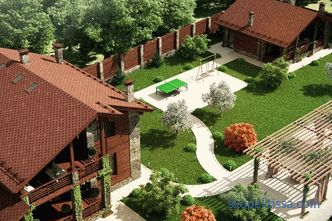Today we will deal with such a thing as "garden drainage." That is what this system is, what it is built from, according to what rules, difficulties that builders face when organizing this engineering system. Be sure to talk about the technology of its construction.
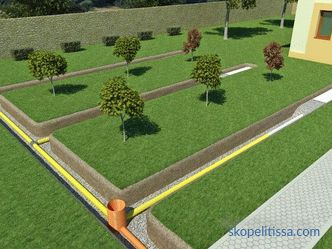
Why do we need drainage in the garden plot
Ask any builder or landscape designer, where to start to equip a country site. The answer is one - with drainage, if required. And, as practice shows, such a need is almost always present.
And it is necessary to start with it just because the creation of a drainage system is a huge amount of earthworks. Almost the entire suburban area will have to dig ditches. And if any buildings have been erected on the site, they will simply interfere with the construction of drainage.
It is necessary to add that the construction of a drainage system is an expensive process. Therefore, many private developers refuse it, referring to the fact that just recently everyone managed without it. The argument, frankly, is weak. After all, life over the past year has become better. For a long time, small dachas, knocked together from boards, went into oblivion. They were replaced by houses built of stone or wood, in case of emergency, using frame technology, but sheathed with modern materials.
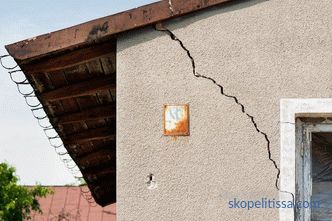
That is, everyone wants to live comfortably and beautifully. Why do some people refuse to equip a personal plot, to create a beautiful landscape design, in which drainage plays an important role. But its absence can lead to serious problems, where puddles after rain, dirt on the garden paths, poorly growing plants are just “flowers”. The consequences can be much more serious, for example, sagging foundation, hence the cracks on the walls.
What is drainage
In essence, this is a system by which water is removed from the surface of the ground or from a certain depth. This is one of the water systems. With its help, it achieves the following:
-
Water is removed and moisture from the areas where the foundation structures are located. The fact is that excessive moisture, especially for clay soils, causes the foundation to move. As builders say, it will "float", that is, it will become unstable. If we add to this the frosty heaving of the soil, then the earth will simply push the structure out.
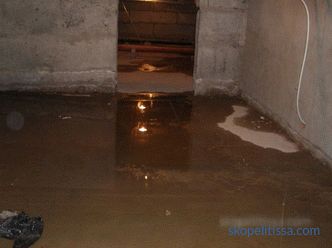
-
Basement and basement floors are being drained. Many may note that modern waterproofing materials are able to withstand any exposure to water, in any quantity. No one is going to argue with that. Simply, each material has its own operational resource. After a few years, he and the most high-quality waterproofing material runs out. That's when the problems begin. In addition, there is always the likelihood that there is a defect in some part of the insulation through which moisture will penetrate into the basement.
-
If autonomous sewage with a septic tank is used in the suburban area, the drainage will help the latter to be held in the ground . Taking into account, if at the country increased groundwater level.
-
It is clear that the drainage system makes it impossible to overwet the soil . So, we can say that the plants planted in the ground, will grow normally.
-
If the summer cottage is an area located on the slope , then rainfall will wash away the fertile layer at precipitation. This can be avoided by arranging drainage on a section with a slope to which water flows are diverted. That is, they will be removed by an organized system, without affecting the soil.
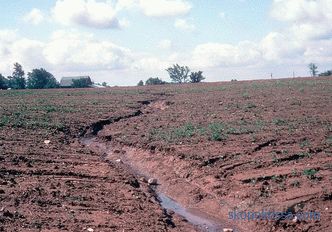
We must pay tribute to what is not required in all suburban areas creation of a drainage system. For example, if it is located on a hill. Basically, there is always a need for it. Let's look at situations in which drainage is indispensable.
On our website you can familiarize yourself with the most popular sites in the Moscow Region for the construction of a country house . In filters you can set the desired direction, the presence of gas, water, electricity and other communications.
When the drainage should be organized
That is, we indicate those cases when the drainage system is necessary in any case.
-
If the summer cottage is located in the lowland . All precipitations along the slope will flow here. The laws of physics has not been canceled.
-
If the site is located on flat terrain , the soil is clayey, the groundwater level is high (not less than 1 m).
-
Drainage in the area with the slope (strong) is also necessary.
-
If you plan to build buildings with deep-laid foundations .
-
If, according to the project, the main part of the territory of the summer cottage is covered with waterproof layer : concrete or asphalt paths and platforms.
-
If lawns, flower beds are equipped with automatic watering .

How to start the construction of drainage
It is necessary to begin with studies of a country site for the type of soil, the level of groundwater and the type of relief. This can be done only by professionals, conducting geological and geodetic surveys. Usually they do topography of the plot, where cadastral borders of the villa are defined. Determine the terrain (wavy or even, with a bias in which direction), soil type, making exploration the way of drilling, and the physico-chemical properties of the soil. Be sure to indicate in the reports GWL.
Based on the data provided, recommendations are made on the depth of foundation of the foundations, the type of waterproofing and the drainage system. Sometimes it happens that experts generally do not recommend building large houses with basements, as the owners of a country plot conceived. Which leads the last to bewilderment. Disappointments appear, but there is no way out.
It is clear that all the research conducted is worth the money, sometimes a lot. But you should not avoid these costs, because the information obtained will subsequently save much larger capital investments. Therefore, all these studies, only at first glance, are unnecessary procedures. In fact, they are useful and necessary.
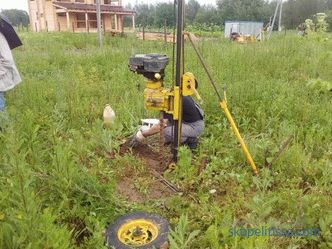
Drainage types
It should be noted that in the classification of drainage systems a fairly large number of species. And in different sources, this number may differ dramatically, plus the names of the systems will be different. In this article we will talk about the most simple but effective measures, how to lower the water level at the dacha.
This may be interesting! In the article on the following link read about the drainage device - the stages of work and their cost .
Surface drainage
This is the simplest system consisting of open ditches, which is called stormwater. That is, its main task is to collect and remove precipitation and water from melted snow. Ditches can be simply dug in the ground or collected from concrete or plastic trays.
Ditches dug in the ground are covered with rubble or pebbles so that they do not litter. Or left open. So that the walls of the ditches do not crumble, they are decorated with stones or other durable and waterproof materials. As for the finished trays, they are closed with metal or plastic grids.
Usually such a system is arranged along the tracks, along the perimeter of the sites and buildings. Therefore, when the task of constructing drainage for paths in the garden plot is set, it is the open variety that is used.
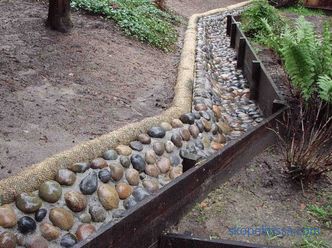
Storm sewage can be assembled from pipes that are laid in ditches to a shallow depth. In this case, the pipe wiring is connected to the reception funnels, where the water from the street is drained. Such funnels are usually installed under the risers of the drainage systems of the roofs of buildings and structures, as well as on the territory of the summer cottage, where intensive drainage is required.
Depth
This system is made of perforated pipes, called drains, installed at a certain depth. Usually below the groundwater level. When they talk about the drainage of the garden plot, they imply this kind of drainage system. Its main task is to lower the level of groundwater, that is, to conduct a partial drainage of the site.
About her and we will talk further.
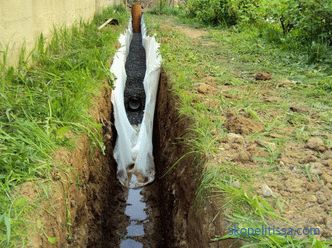
How the drainage system is constructed
First of all, you need to decide on the layout drainage pipes. Basically use two: ring and herringbone. The first is a few rings around the main house, interconnected by pipe bridges, through which water passes from one level to another and then beyond the site or into a drainage well, where all the water is collected. Already from here it is pumped out of the garden area or flows by gravity.
The second is one straight-line contour from the house to the drainage well, to which additional contours are connected.To make it clear what we are talking about, look at the photo below, where you can clearly see how the contours of the drainage system will be arranged according to the herringbone scheme.
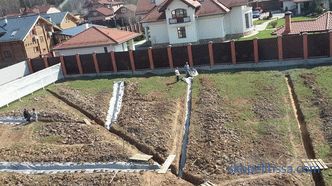
It might be interesting! In the article on the following link read about drainage and storm sewage system at .
We must pay tribute to the fact that the herringbone is a simpler option. We will disassemble it.
Materials for drainage
In the construction of drainage ditches at the dacha use plastic pipes of low-pressure polyethylene (HDPE), corrugated type. In addition, they are perforated. Manufacturers offer pipes of standard sizes with a diameter of 63 to 200 mm. This size is chosen taking into account the volume of water discharged.
Since the pipes will be located in the ground, it is possible to say with 100% probability that after a year of operation they will be clogged with soil. Therefore, they are wrapped in geotextile at the factory - non-woven material that even the smallest particles of soil will not miss, but the water will pass through it without problems. Coconut-wrapped drainage pipes are on the market.
In the video, an expert gives an overview of the drainage pipes present in the modern building materials market:
In addition to the pipes, fittings from the same PND are attached. These are bends, double-sided couplings, tees and crosses, as well as various shaped articles. It is clear that with their help, pipe wiring is connected to a drainage circuit. In addition, manufacturers offer different types of manholes. Usually they are carried out through the inspection of the drainage system, cleaning pipes. The photo below shows such a well installed on a shaped product to which four pipes are connected at once.
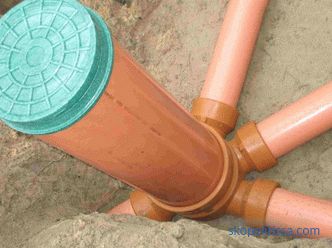
I would like to note that the manholes are installed every 50 m in straight sections or at the junction several contours at once, as shown in the photo.
Preparatory work
First of all, a drainage scheme is applied to the territory of the garden plot. This can be done with a chalky dressing or with pins tied into the ground, tied with string. Determine the place of the collecting well, where water will be collected. Usually for this choose the lowest place.
Dugs under the pipes are dug along the contours applied. Since the drainage is a gravity system, the ditches are dug at an angle towards the well. Tilt angle 2-7 °. Immediately determine the slope is difficult, so the ditches are covered with geotextile, sand is covered with a thickness of 10 cm, and then the gravel layer is covered with a thickness of 20 cm. It is at this stage that the angle of inclination is checked.
Dig a foundation pit under the collection drainage well. Its depth is determined by the inlet of the reservoir and the end of the drainage piping. They should be on par. The pit is filled with a sand layer 10-20 cm thick.

It can be interesting! In the article on the following link, read about drainage systems of the suburban area: features, types, design .
Assembly of pipe wiring
In principle, there is nothing difficult in this process, because the pipes are laid in prepared ditches. Be sure to check them on the angle with a protractor. Connect the fittings to each other and bring them to the well. Then carry out the installation of the drainage tank.
To do this, you can purchase a finished plastic container or assemble a well of reinforced concrete rings. The first option for all positions is better: the plastic tank is cheaper, it is light, so installation does not require the presence of special equipment in the form of a crane. The only thing that experts recommend is to bind the tank by any means so that during the frosty heaving period it will not be pushed out of the ground. One of the ways is to pour from two sides concrete tables, to which a plastic well is tied with chains or cables.
It remains only to connect the well to the end of the drainage pipe, for which a two-way coupling is used. Installation of the drainage system is completed. It remains to fill the pipes with rubble, wrap the multi-layer construction with the edges of the geotextile and cover it with soil. Well fall asleep only ground.
The video shows the step-by-step sequence of the construction of the drainage system in a suburban area:
How to properly lay the drainage pipes near the foundation
If the drainage system starts to be laid on the garden plot, where houses are already built, then a very serious problem forms the bottom. These are the areas around the foundation that are excavated below the foundation structure. It turns out that the basis of the house remains without support from the ground. This can lead to the fact that the foundation will “disperse” in different directions, and the house will simply fold inward.
This problem can be solved by using a special technology.
-
A trench 20 m long is dug along one side of the section.
-
It is filled with sand and rubble, necessarily pre-laid geotextiles.
-
Lay the pipe .
-
Fill it with rubble , leaving half a meter of pipe on each side free.
-
Wrap the plot with geotextile and cover it with soil.
-
Next to they dig a second trench 20 m long.
-
Do the same operations, connecting the among themselves.
-
And thus around the perimeter of the house.
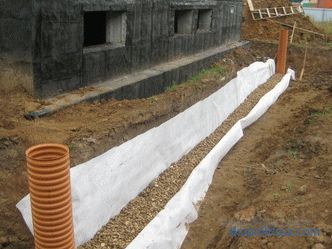
How to lay a drainage pipe under the paths
Drainage under the tracks laid on the puncture. In principle, if the walkway is of small width, this can be done manually with a shovel. If the width of the sidewalk or the road is not less than 3 m, then one cannot do without special equipment.
Watch a video showing how this equipment is punctured:
It might be interesting! In the article on the following link read about turning the garage into a comfortable loft-style house .
Conclusion on the topic
It should be noted that after reading this article, the residents of the desert and steppe regions will only sadly say that we would have such problems. After all, they have water in great scarcity. Residents of many regions of Russia are lucky, because they live where there are no problems with fresh water. And drainage simply helps many of them not to face another kind of problem - waterlogging of garden plots. So it is not known who was lucky.
